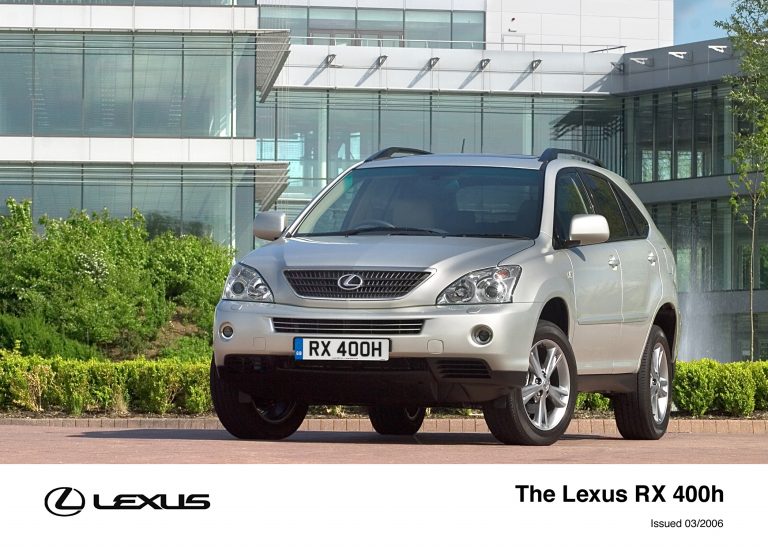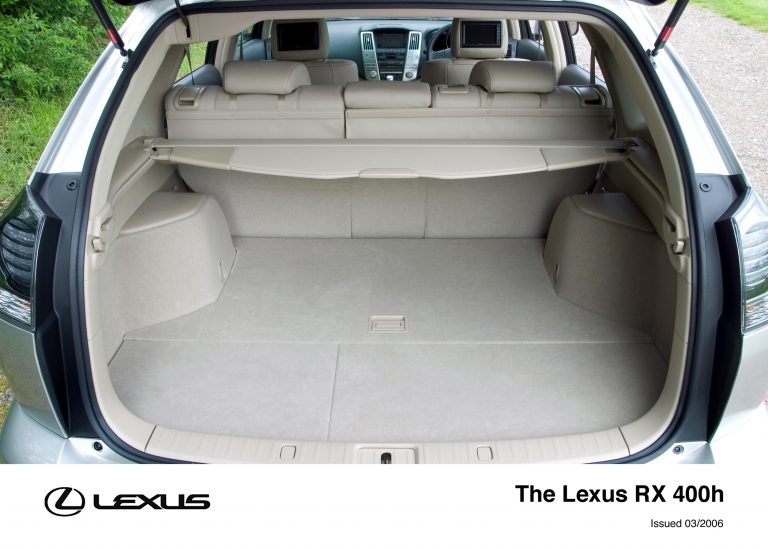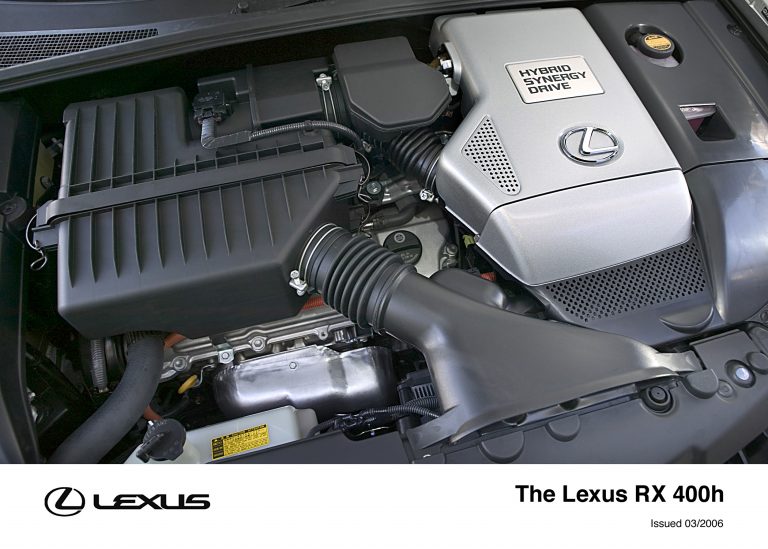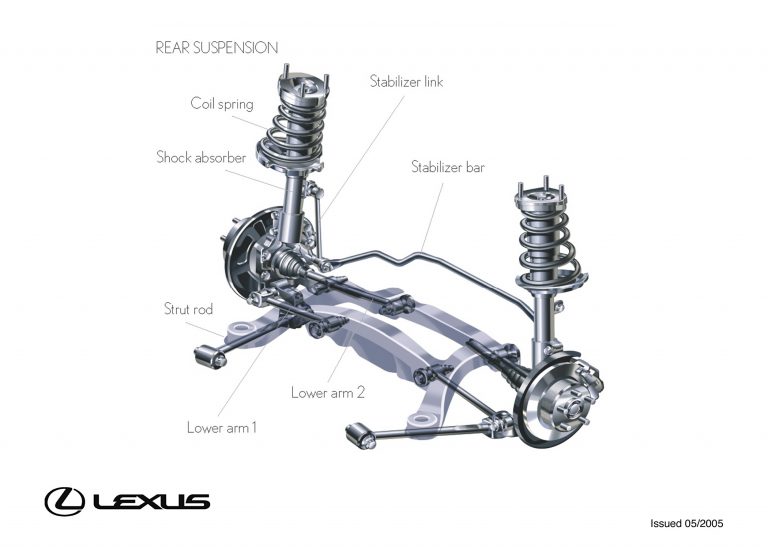The New Lexus RX400h
KEY POINTS
- Unique, Lexus-designed hybrid powertrain technology provides excellent performance and reduces environmental impact
- 3.3-litre V6 petrol engine and a front and rear electric motor give combined output of 272bhp
- Maximum speed 124mph and seamless acceleration from rest to 62mph in 7.6 seconds (preliminary figures)
- Lowest combined fuel consumption for any automatic transmission premium SUV, 34.9mpg (preliminary figure)
- Advanced use of “by wire” electronic technology
- Energy efficient Electric Power Steering (EPS)
- Advanced Vehicle Dynamics Integrated Management provides exceptional vehicle stability control
- Electronically Controlled Braking system (ECB) ensures effective stopping power and assists in energy regeneration
- Electric air conditioning improves fuel efficiency and delivers more effective cooling
INTRODUCTION
The Lexus RX400h marks an important step forward in the development of Lexus, introducing the exceptional efficiency and strong environmental performance of hybrid power to the luxury SUV market. Due to be launched in the UK in June this year, the RX400h is most the advanced and innovative Lexus production model yet.
The ‘h’ in the name RX400h denotes the vehicle’s bespoke hybrid powertrain, the powertrain has been developed to provide the kind of performance demanded of a top quality SUV, delivering the speed and output normally expected of a 4.0-litre machine – hence the ‘400’ classification.
But rather than having a fuel-thirsty V8 under the bonnet, the RX400h combines a 3.3-litre V6 petrol engine with two powerful electric motors, positioned front and rear. These elements work separately or together to provide eminently smooth and powerful performance, while returning consumption figures that the RX400h’s conventionally-powered rivals cannot match.
Lexus’s global reputation is built on peerless quality and there has been no compromise in this philosophy where the development of the RX400h is concerned. The vehicle offers just the same levels of quality, refinement and luxury as its sister RX300 models, but with the bonus of advanced technologies that address environmental concerns in terms of fuel consumption and exhaust emissions.
The RX400h boasts more “by wire” electronic technology than any other production car. This includes braking and throttle systems that provide quicker and more effective responses and Vehicle Dynamics Integrated Management (VDIM), the world’s most advanced vehicle stability control system.
Electric power steering is another element in the multi-dimensional approach to saving energy, together with a unique electric air conditioning system that works independently of the vehicle’s engine for quicker and more efficient cooling.
“This is the first time that hybrid technology has been applied to a premium segment car,” said Stuart McCullough, Director of Lexus Europe, “and we believe it will surprise many people in terms of what this technology holds for cars of the future, and particularly for Lexus.
“Hybrid technology represents precisely the type of driving characteristics that are the hallmark of Lexus engineering. Our powertrain is incredibly smooth, powerful and refined, yet gives a highly engaging and rewarding driving experience. And this is only the start of our involvement with hybrid technology. Lexus is placing an enormous significance on the future of this drivetrain technology.”
LEXUS AND HYBRID TECHNOLOGY
Lexus Division engineers have created a new hybrid system for the RX400h based on the Hybrid Synergy Drive concept with re-designed and refined electric systems, mechanical driving components and control elements which achieve high power and performance levels.
It uses a series parallel hybrid system with two powerful electric motors and a highly efficient 3.3-litre V6 petrol engine working in tandem to give the vehicle an intelligent electric four-wheel drive capability and significantly improve low to mid-range acceleration, braking and fuel efficiency, while minimising carbon dioxide emissions.
Hybrid characteristics
The RX400h’s Hybrid Synergy Drive system combines the following characteristics to deliver superior fuel efficiency and driving performance.
- Energy loss reduction: the system automatically stops the engine at idle, reducing the amount of energy that would usually be wasted.
- Energy recovery and reuse: energy that would normally be lost as heat during deceleration and braking is recovered as electrical energy and used to power the starter and electric motor.
- Motor assist: during acceleration and the engine is supported by power from the electric motor.
- High efficiency control: the system maximises the vehicle’s overall efficiency by using the electric motor to power the vehicle in conditions where engine efficiency is low and by generating electricity when engine efficiency is high.
Hybrid synergy drive in operation
Over the course of any journey the RX400h’s Hybrid Synergy Drive will operate in several different modes to maximise overall efficiency. At rest, the engine stops automatically to conserve fuel. Under conditions of low engine efficiency, such as start-up and low to mid-range speeds, the vehicle runs on its electric motors alone, reducing CO2 emissions to zero.
In normal driving conditions, engine power is divided by the power split device both to drive the wheels directly and to power the generator, which in turn drives the electric motors. In these circumstances power allocation is constantly monitored and adjusted between engine and motors to maximise efficiency. When sharp acceleration is required, engine and electric motors again work together, with extra power supplied by the battery to boost response.
A unique feature of the RX400h’s Hybrid Synergy Drive is a second electric motor that drives the rear wheels. E-four, Lexus’s innovative electric four-wheel drive system operates in various driving conditions. Controlled by the Vehicle Dynamics Integrated Management system (VDIM), four-wheel drive is automatically engaged through constantly adjusted front and rear electric motor torque, during hard acceleration (both from standstill and through the gears), when cornering and whenever the front wheels lose traction.
Moreover, during deceleration and under braking, the engine switches off and both the electric motors act as high-output generators, driven by all four wheels. This regenerative braking system optimises energy management by recovering kinetic energy that would normally be lost as heat as electrical energy for storage in the high performance battery. Battery power level is constantly maintained by the engine-driven generator, which means there is no need for the system to be recharged from an external power source.
In addition to the petrol engine and two electric motors, the system also comprises a generator, a high performance battery, a power split device which combines and re-allocates power from the engine, electric motors and generator according to requirements, and a power control unit which governs the high speed interaction of the system components.
Electrical power enhancements to the new Hybrid Synergy Drive include the use of a boost converter to increase generating capacity. A new, high speed front motor operates at twice the speed and delivers more than double the power of the one used in the Toyota Prius. The addition of a rear motor facilitates four-wheel drive and a new high power nickel-metal hydride battery is used.
At all speeds, the Hybrid Synergy Drive system monitors itself for optimum performance and fuel efficiency with minimum emissions and adapts accordingly to run the electric motors in isolation, the engine in isolation, or a combination of both. The driver can see which power sources are being used by means of a dedicated instrument readout which replaces the usual rev counter. In versions with satellite navigation, power flow and battery status are shown on a seven-inch colour monitor.
PERFORMANCE
The Lexus RX400h uses a 3.3-litre 211bhp V6 petrol engine, a high powered front-mounted electric motor and a rear electric motor that drives the rear wheels when necessary. Together they combine to produce a maximum output of 272bhp.
The Hybrid synergy Drive system gives a maximum speed of 124mph. Using a continuously variable transmission, it accelerates seamlessly from nought to 62mph in 7.6 seconds (preliminary figures).
The new Lexus complies with Euro IV emissions standards and produces much lower CO2 emissions than rival premium SUVs – equivalent to up to 2.6 tonnes per annum (calculation based on combined EC cycle with 13,500 miles driving).
BY-WIRE FUNCTIONS
The RX400h features more “by wire” technology than any other car on the road. This includes brake and throttle systems that help save weight and space and which respond quicker than mechanical systems, and responsive Electric Power Steering that helps save fuel and reduce noise.
It marks the European debut of Vehicle Dynamics Integrated Management (VDIM), an advanced stability control system, and is equipped with the world’s first electric air conditioning compressor.
Electric Power Steering (EPS)
The Electric Power Steering (EPS) is powered by a brushless 42v DC motor. It consumes electricity only when power is required, using no energy, for instance, when the vehicle is moving in a straight line. This helps reduce fuel consumption by about 1.5 per cent.
The system structure is also more compact and operates more quietly than comparable hydraulic systems. The absence of power steering fluid also makes it more environmentally friendly when it comes to vehicle disposal.
Electronically Controlled Brake System (ECB)
The “by-wire” ECB system not only improves overall braking performance, but also improves the level of brake energy regeneration.
A sensor detects the amount of force being applied to the brake pedal and appropriate hydraulic braking power is applied to each wheel, with an ECU adjusting the pressure at the hydraulic source.
The system operation features a combination of hydraulic braking power and regenerative power from the front and rear electric motors under deceleration. A hydraulic pressure control function balances the total braking force between that supplied by hydraulics and by the motors.
Brake Assist (BAS)
The Brake Assist function automatically enhances braking performance when braking speed is judged to be faster than usual and emergency braking is necessary. These conditions are recognised by a computer monitoring data from the master cylinder pressure sensor and the ECB’s pedal stroke sensor.
BA has consistently proved effective in circumstances where the driver is panicking and not applying sufficient brake pedal force, or where the driver cannot sustain sufficient pedal pressure over a period of time, resulting in deteriorating braking force.
Vehicle Dynamics Integrated Management (VDIM)
Until now, active safety systems such as ABS, traction control (TRC), stability control (VSC) and Electric Power Steering, have tended to evolve independently, even when fitted to the same vehicle. As such, their successful operational combination has been limited and their optimum performance potential unrealised.
VDIM has been developed specifically to integrate these systems, greatly improving active safety and enhancing vehicle performance across the driving spectrum.
Moreover, whereas conventional active systems are only activated after the vehicle’s performance limit has been reached, VDIM activates control before that point. As a result, the performance threshold is improved and the vehicle performs more smoothly, with less obtrusive intervention of the safety systems.
The heart of the VDIM system is a control execution programme built into the ECB’s electronic control unit. The VDIM system constantly gathers information sensors throughout the vehicle, including the brake master cylinder pressure, brake pedal pressure, steering angle and torque, accelerator pedal pressure, vehicle yaw rate, vehicle acceleration, brake calliper pressure at each wheel and torque output from the hybrid vehicle system.
Using this vehicle status data, VDIM not only integrates the RX400h’s ABS, TRC, VSC and EBD functions with the Electric Power Steering, but also co-ordinates control of the Hybrid Synergy Drive and electric four-wheel drive systems.
This helps counter such hazardous driving conditions where, for example, a variation in left and right tyre grip causes the vehicle to pull to one side under braking; where rear tyre grip is lost through braking in a corner; and where stronger braking in a corner causes the rear wheels to lock up.
Air conditioning with electric compressor
Unique to Lexus, the RX400h features the world’s first electric air conditioning compressor with a built-in inverter and brushless DC motor.
In conventional air conditioning systems the compressor is powered by the vehicle engine, but in the RX400h it runs off the high voltage battery with revolution speed controlled by the integrated inverter. This means you do not need to have the engine running in order to keep the vehicle cabin cool. The system is also more fuel-efficient and its cooling efficiency is greater.
LEXUS RX400h PRELIMINARY TECHNICAL SPECIFICATIONS
| PETROL ENGINE | |
| Engine code |
3MZ-FE |
| Configuration |
V6 |
| Valve mechanism |
DOHC 24-valve |
| Displacement (cc) |
3,311 |
| Max. power (bhp/rpm) |
211 @ 5,600 |
| Max. torque (Nm/rpm) |
288 @ 4,400 |
| Compression ratio (:1) |
10.5 |
| Bore x stroke (mm) |
92.0 x 83.0 |
| Fuel type (RON) |
95 or more |
| FRONT ELECTRIC MOTOR | |
| Max. power (bhp/rpm) |
167 @ 4,100 – 5,000 |
| Max. torque (Nm/rpm) |
340 @ 0 -2,000 |
| Max. rpm |
12,400 |
| Max. voltage |
650 |
| REAR ELECTRIC MOTOR | |
| Max. power (bhp/rpm) |
68 @ 4,500 – 5,300 |
| Max. torque (Nm/rpm) |
130 @ 0 – 400 |
| Max. rpm |
10,000 |
| Max. voltage |
650 |
| GENERATOR | |
| Max. power (bhp/rpm) |
148 @ 13,000 |
| Max. rpm |
13,000 |
| Max. voltage |
650 |
| HIGH VOLTAGE BATTERY | |
| Power (kW) |
45 |
| Voltage |
288 |
| Modules/cells |
30 modules; 240 cells |
| Capacity (ah) |
6.5 |
| PERFORMANCE | |
| Max. speed (mph) |
124 |
| 0-62mph (sec) |
7.6 |
| FUEL CONSUMPTION & EMISSIONS |
(PRELIMINARY FIGURES) |
| Extra urban (mpg) |
37.7 |
| Combined (mpg) |
34.9 |
| Urban (mpg) |
31.4 |
| CO2 emissions (g/km) |
192 |
| Compliance level |
Euro IV |
| SUSPENSION | |
| Front |
MacPherson strut |
| Rear |
MacPherson strut |
| BRAKES | |
| Front |
320mm ventilated discs |
| Rear |
288mm solid discs |
| WHEELS AND TYRES | |
| Wheels (front and rear) |
Alloy, 18in |
| Tyres (front and rear) |
235/55 R18 |
LEXUS RX400h PRELIMINARY TECHNICAL SPECIFICATIONS contd.
| DIMENSIONS | |
| Overall length (mm) |
4,755 |
| Overall width (mm) |
1,845 |
| Overall height (mm) |
1,675 |
| Wheelbase (mm) |
2,715 |
| Track – front (mm) |
1,555 |
| Track – rear (mm) |
1,550 |
| Overhang – front (mm) |
990 |
| Overhang – rear (mm) |
1,040 |
| Coefficient of drag (Cd) |
0.33 |
| Fuel tank capacity (l) |
65 |
| WEIGHTS (kg) | |
| Kerb weight |
2,000-2,040 |
| Gross vehicle weight |
2,505 |
| TOWING CAPACITY (kg) | |
| Unbraked |
700 |
| Braked |
2,000 |
| STEERING | |
| Type |
Rack and pinion |
| Ratio |
15.6 |
| Turns (lock to lock) |
2.9 |
| Min. turning radius – tyre (m) |
5.7 |
ENDS





